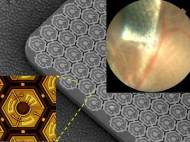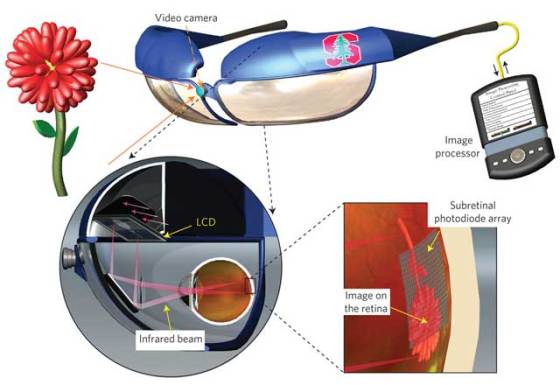Photovoltaic retinal prosthesis with high pixel density
 Scientists at the Stanford University School of Medicine have devised a system that could ultimately be used to restore sight to people who have lost vision due to certain types of degenerative eye diseases. Although their results were achieved on rat retinas, the scientists are now testing the system in live rats, taking both physiological and behavioral measurements, and they are searching for a sponsor to who’ll support tests in humans.
Scientists at the Stanford University School of Medicine have devised a system that could ultimately be used to restore sight to people who have lost vision due to certain types of degenerative eye diseases. Although their results were achieved on rat retinas, the scientists are now testing the system in live rats, taking both physiological and behavioral measurements, and they are searching for a sponsor to who’ll support tests in humans.
The proposed prosthesis is intended to help people suffering from retinal degenerative diseases, such as age-related macular degeneration and retinitis pigmentosa. In these diseases, the retina’s photoreceptor cells slowly degenerate, ultimately leading to blindness, however, the inner retinal neurons that normally transmit signals from the photoreceptors to the brain are mostly intact.
“In our model we replace those photoreceptors with photosensitive diodes”, said Daniel Palanker, Associate Professor and director Director of Research at Stanford’s Department of Ophthalmology. “Every pixel is like a little solar cell; you send light, then you get current and that current stimulates neurons in the inner nuclear layer of the retina.”
This new type of retinal prosthesis involves a specially designed pair of goggles, which are equipped with a miniature camera and a pocket PC that is designed to process the visual data stream. Unlike the regular video goggles, the scientists envision that the recorded images would be beamed from the LCD using laser pulses of near-infrared light to a 70 µm photovoltaic silicon chip implanted beneath the retina. Electric currents from the photodiodes on the chip would then trigger signals in the retina, which then flow to the brain, enabling a patient to regain vision.
Virtually all of the hardware is incorporated externally into the goggles. The surgeon needs only to create a small pocket beneath the retina and then slip the photovoltaic cells inside it. Another benefit of this system is the possibility to tile these photovoltaic cells in larger numbers inside the eye to provide a wider field of view than the other systems provide.
In their study, Palanker and his team fabricated a chip about the size of a pencil point that contains hundreds of these photosensitive diodes. To test how these chips responded, the researchers used retinas from both normal rats and blind rats that serve as models of retinal degenerative disease. The scientists placed an array of photodiodes beneath the retinas and placed a multi-electrode array above the layer of retinal ganglion cells to detect their activity.
They conducted tests with pulses of normal and near-infrared light, to produce electric current in the photodiodes and measured the response in the outer layer of the retinas. The ganglions of normal rats stimulated by the normal visible light reacted as expected, but they also presented a similar response to the near-infrared light – thus confirming that the diodes do trigger neural activity. On the other hand, the degenerative rat retinas vaguely responded to the normal light, but the near-infrared light prompted roughly similar activity to those recorded by normal rat retinas exposed to the same type of light.
Palanker noted that the degenerated rat retinas required greater amounts of near-infrared light to achieve the same level of activity as the normal rat retinas. While there is some concern that exposure to such doses of near-infrared light could cause the tissue to heat up, the scientist claim they found that the irradiation was still one-hundredth of the established ocular safety limit.
Since completing the study, Palanker and his colleagues have implanted the photodiodes in rats’ eyes and been observing and measuring their effect for the last six months. He claims that preliminary data looks promising since it indicates that the visual signals are reaching the brain in normal and in blind rats, though the study is still under way.
Unlike other currently available retinal prosthesis which require coils, cables or antennas inside the eye to deliver power and information to the retinal implant, the Stanford device doesn’t require wires since it employs near-infrared light to transmit images. However, just like all currently available retinal prosthesis device, it doesn’t allow people to see pictures clearly and the image that gets transmitted is not in color.
For more information, read the paper published in Nature Photonics: “Photovoltaic retinal prosthesis with high pixel density”.










you will have an amazing weblog here! would you prefer to make some invite posts on my weblog?